
Cat mummies
Many moons ago, I bought a cat mummy kit from L Delaney. One thing I didn’t realize about the kit was that it contained air dry clay. It was hard as a rock, so I used Sculpey terracotta color polymer clay since I have a lot of it and you paint the mummies anyway. It’s also soft and easy to work with.
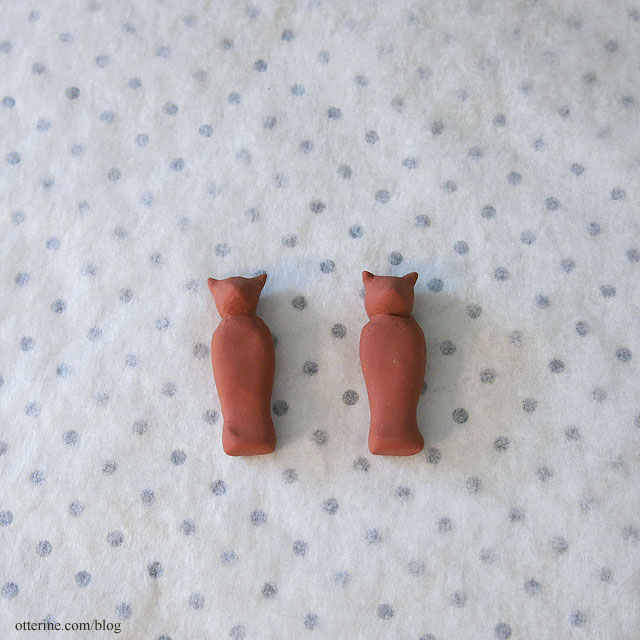
The paint included was also dry but I was able to reconstitute it with water. I made a swatch of it, so I could mix more of a similar color in the future. The kit comes with a lot of paper to use as mummy wrap, and you use 1/16″ wide strips. I could make a lot of mummies, but I started with a pair hoping to get at least one good one.
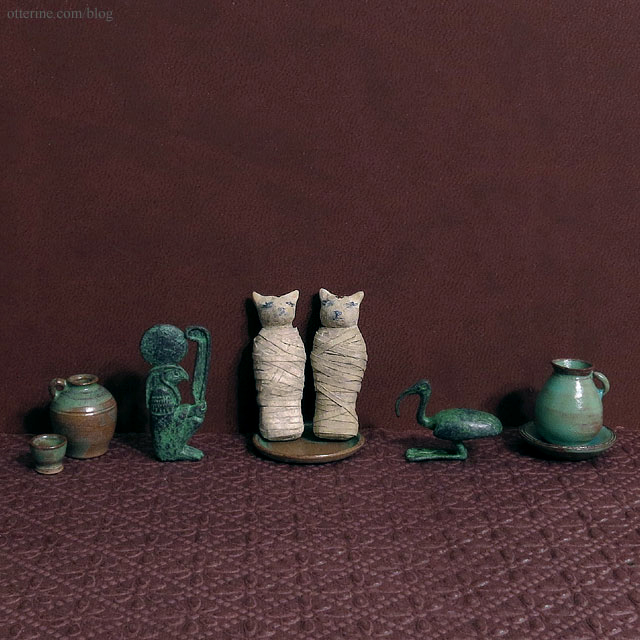
I ended up with two that complement one another well, don’t you think? :D
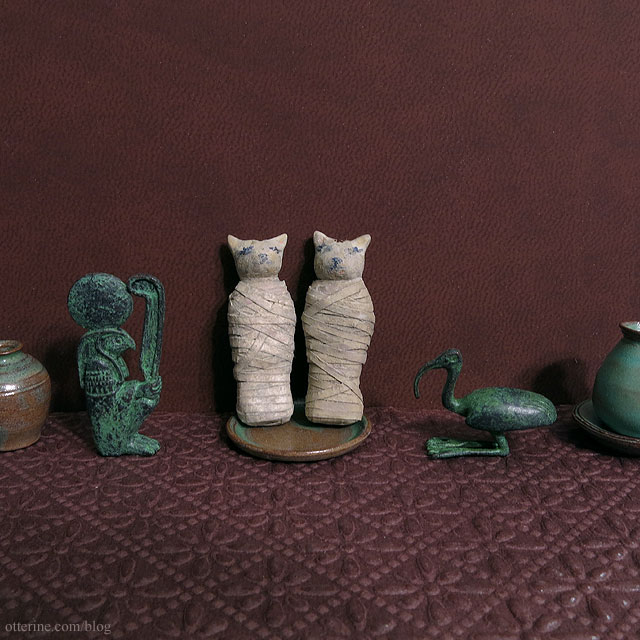
Ra and ibis statues by Neil Carter; ceramics by Carberlin Minis.
Categories: Animals and birds, Miniatures, Polymer clay
July 2, 2022 | 0 commentsHalloween cake with wee ghosts
I made a cake following the tutorial by Maive Ferrando in Dolls House and Miniature Scene magazine. I had to change the method a bit for my own skill level and techniques I’m more comfortable with, and I’m happy with the end result. I made my cake whole and added a tombstone cookie.
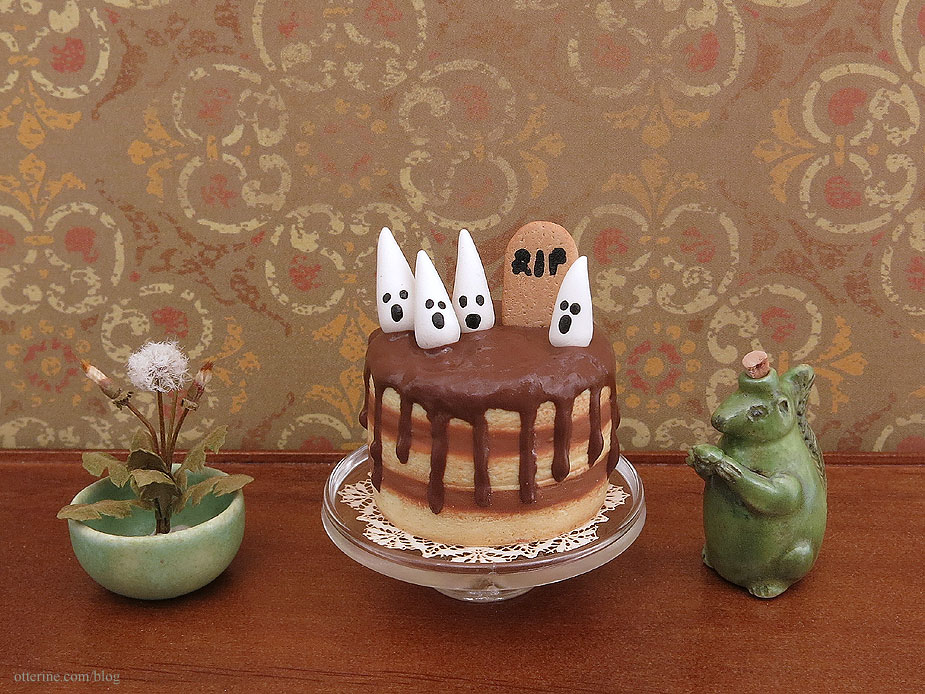
Categories: Miniatures, Polymer clay
October 24, 2021 | 0 commentsZombie apple cookies
In continuing with my polymer clay adventures, I thought I would make some poison apple cookies to go with my poison apple cake. Well, the best laid plans….
After forming the apple cookies, painting on the green icing and then adding the black icing, all was going well. Until the black icing shifted more than expected during baking.
This is what I was going for, and this is the only one that turned out like my vision.
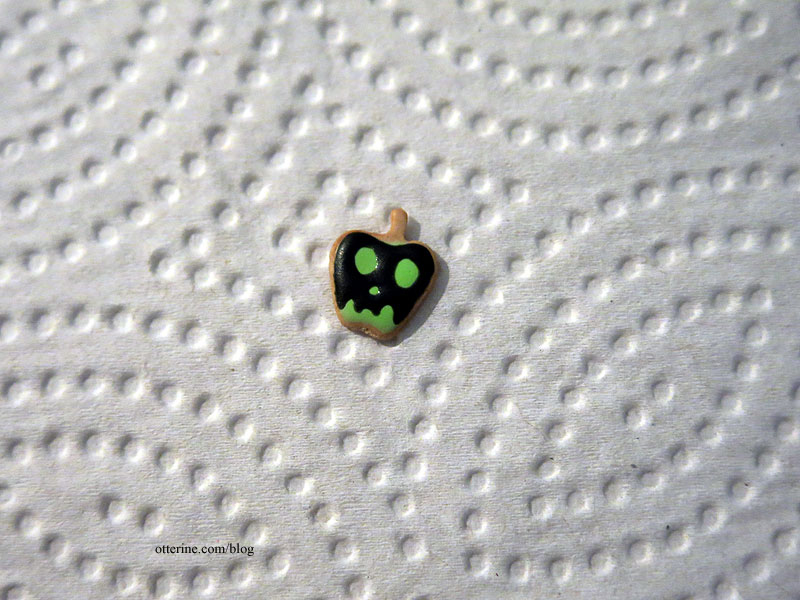
The remaining are these. I thought they were outright fails, until I showed them to my miniaturist group and they raved about them. :D Sometimes I think people are just being nice, but in this case, they bought them all up save four! It made me feel better about my perceived failure and turned these into a happy accident. Thus, the zombie apple cookie was born.
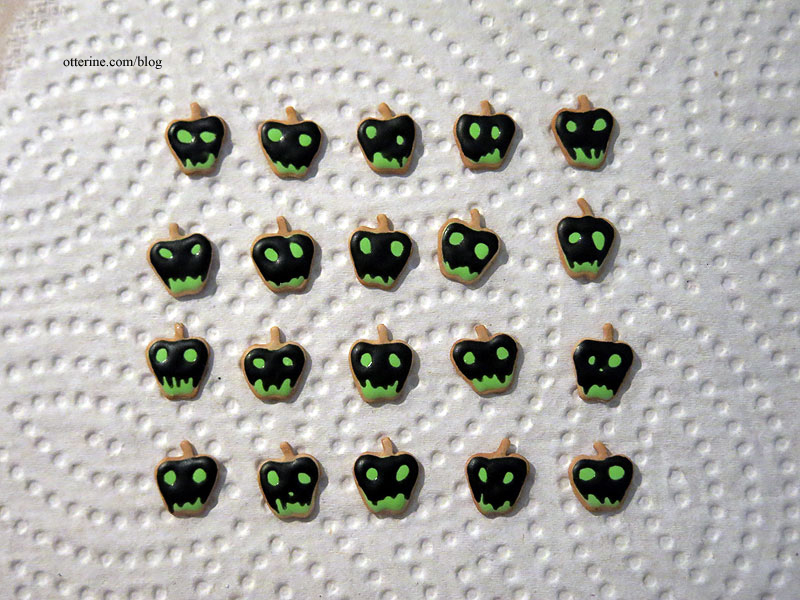
I did end up putting some sets on etsy if anyone else is taken with these zombified cookies.
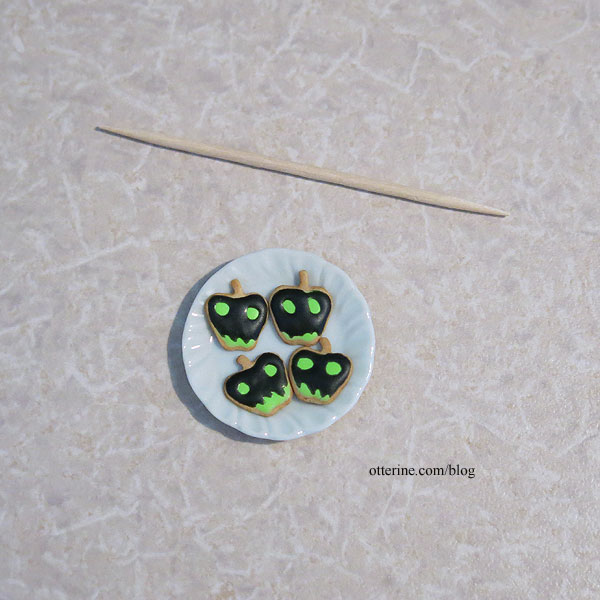
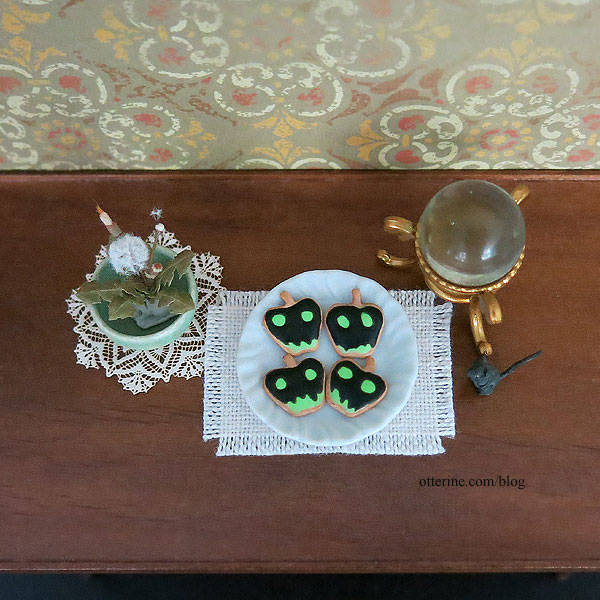
Categories: Miniatures, Polymer clay
October 17, 2021 | 0 commentsPoison Apple Cake
I’ve seen a few examples of poison apple cakes in real life and wanted one in mini. After a few failed attempts, I have a keeper!
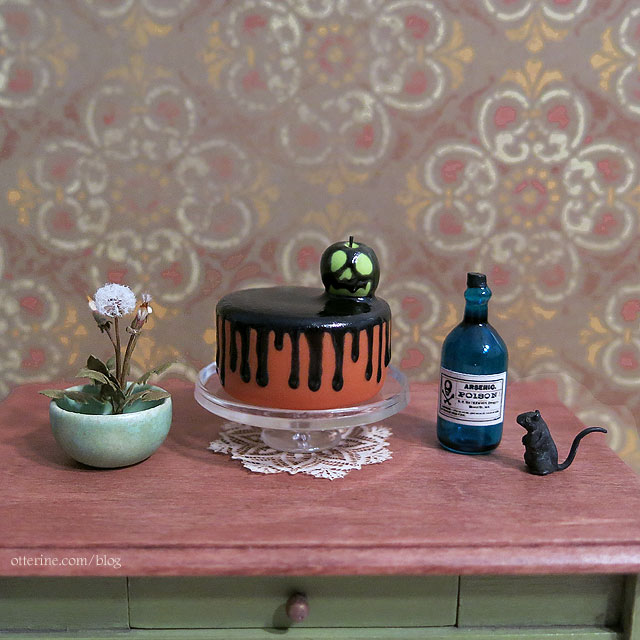
I made two more for a couple of friends. :D These are challenging but so much fun!
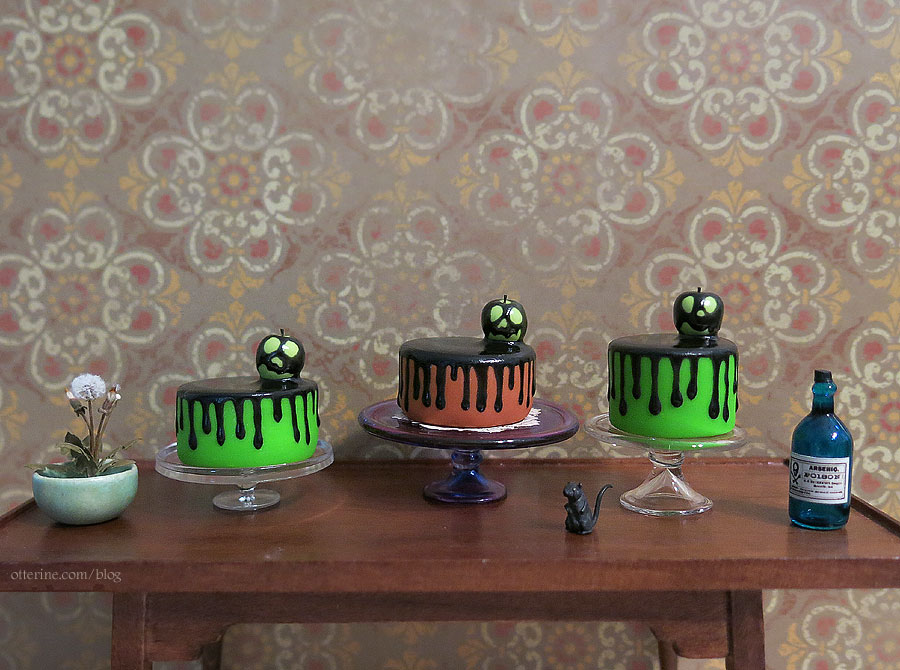
——
You can see the real life inspirations here and here.Dandelion by Lamis Minis, poison bottle from Four Little Walls, doily from Stewart Dollhouse Creations, mouse purchased years ago (unknown vendor).
Categories: Miniatures, Polymer clay
September 3, 2021 | 0 commentsBread dough bowls
This past month, I made up some rising bread dough bowls using polymer clay. Today, I spent time making the kitchen towels used to cover them. In reality, the towel would cover them completely, but in mini, I let some of the dough peek out. Perhaps the baker is checking for readiness. One is for me, but the others will be in my etsy shop.
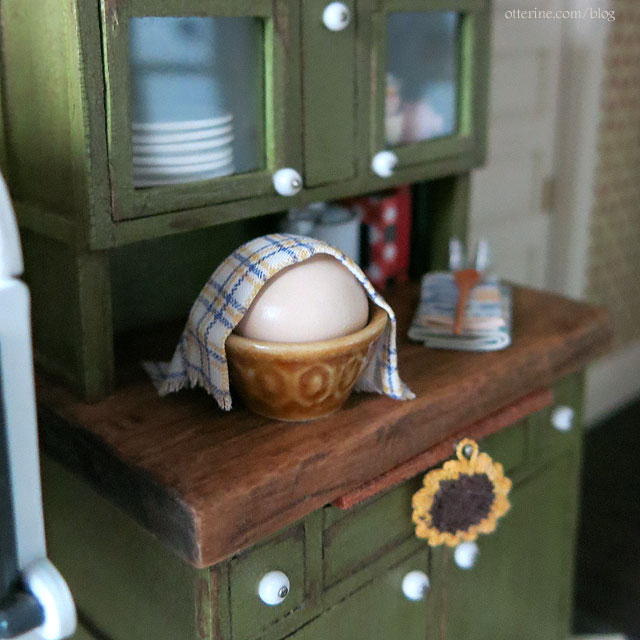
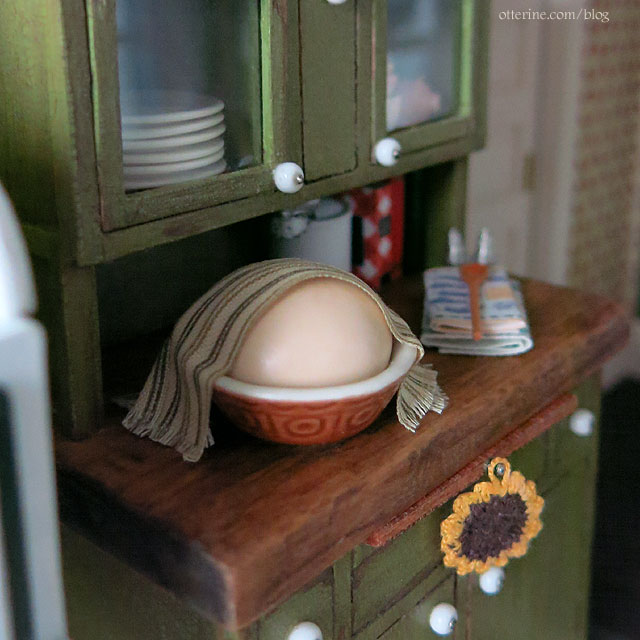
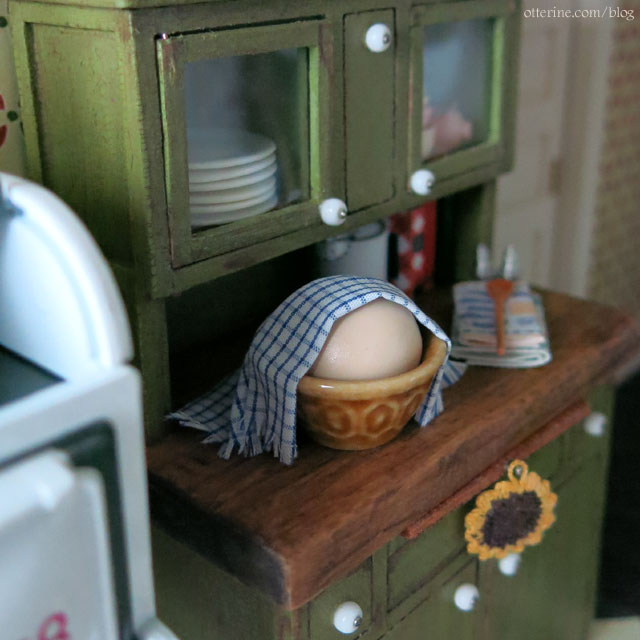
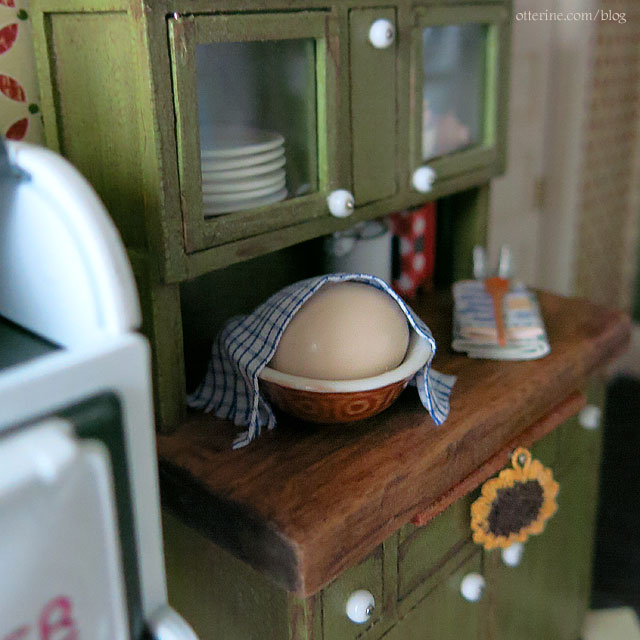
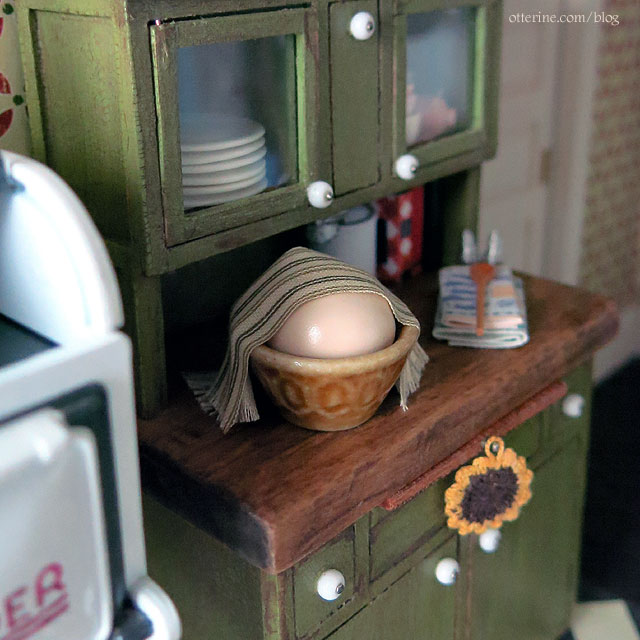
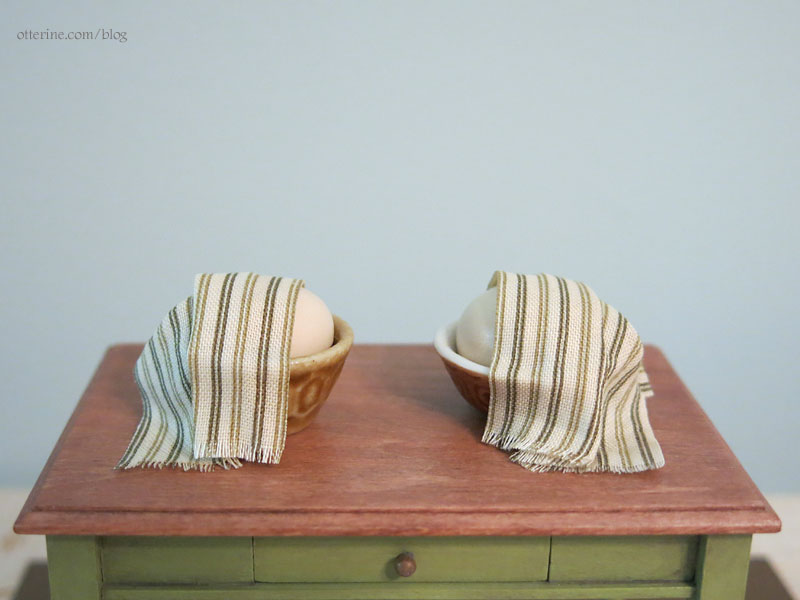
Categories: Miniatures, Polymer clay
August 28, 2021 | 0 commentsHexagon clay tiles, part 3
Continuing work on the hexagon clay tiles. Since my first tile grouping had too much bronzer, I figured it was a good choice to test the grout before trying on my finished tiles. I mixed brown and black paint with spackle to make a gentle (non-scouring) grout that was easy to spread. I used my finger to spread it into the grooves around the tiles.
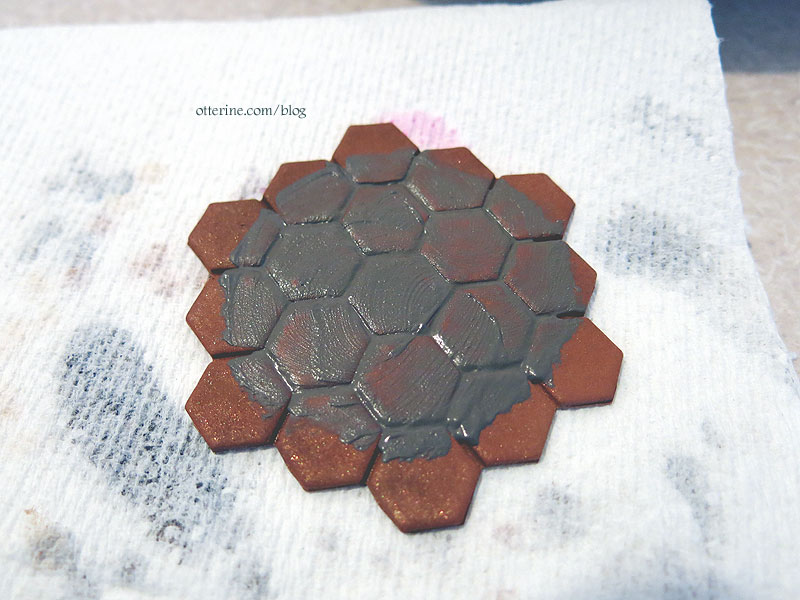
I then wiped away the excess with a wet paper towel. It took a few passes to get it clean. The process lifted some of the tile color I had applied, but the end result was a more even tile so I wasn’t disappointed. If I want more variation, I can always paint after grouting.

I mixed a larger batch for the final floor and masked the areas around the edges where the walls will be glued to the floor board.
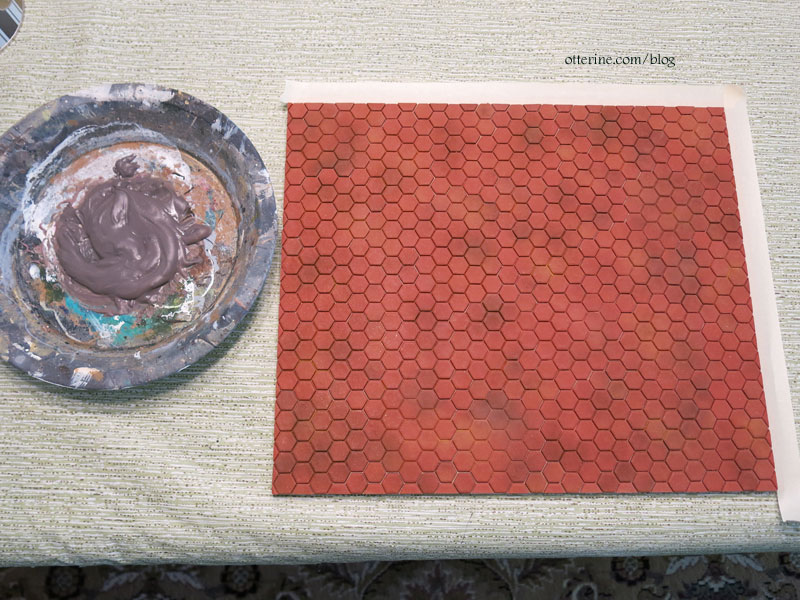
I spread the mixture with my fingers in sections and wiped away some of the excess as I went.
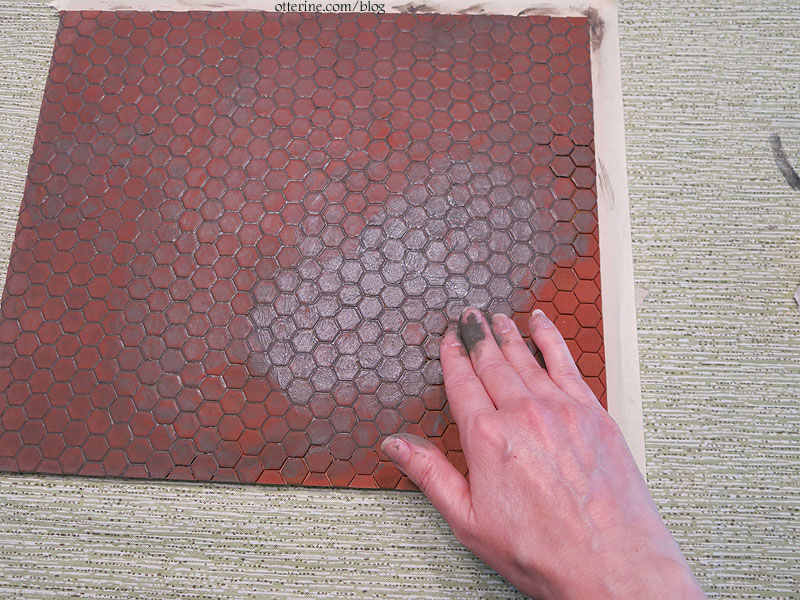
I washed the floor after the grouting was complete with water and paper towel. I saved a bit of the grout mixture just in case I needed to touch up any areas.

The initial wash left streaks, so I used a Q-tip to wash each tile individually.
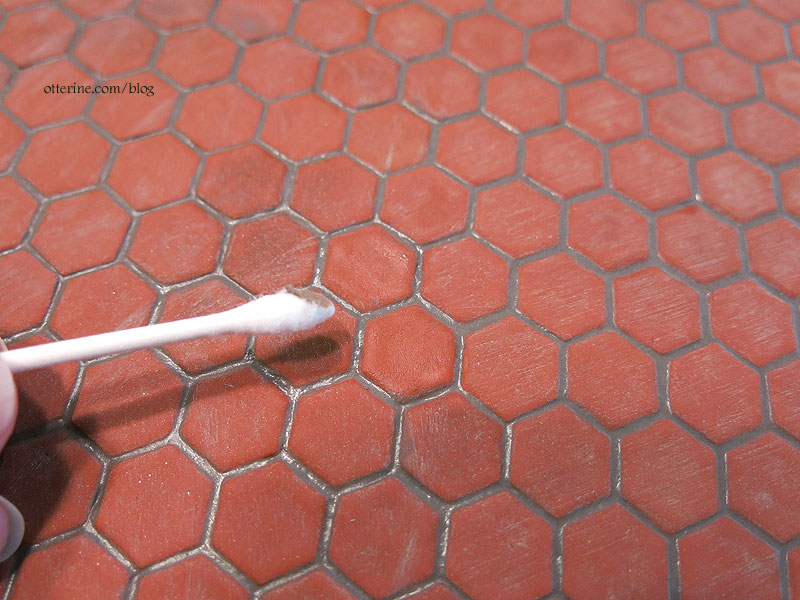
I did small sections and wiped with a dry, clean paper towel.
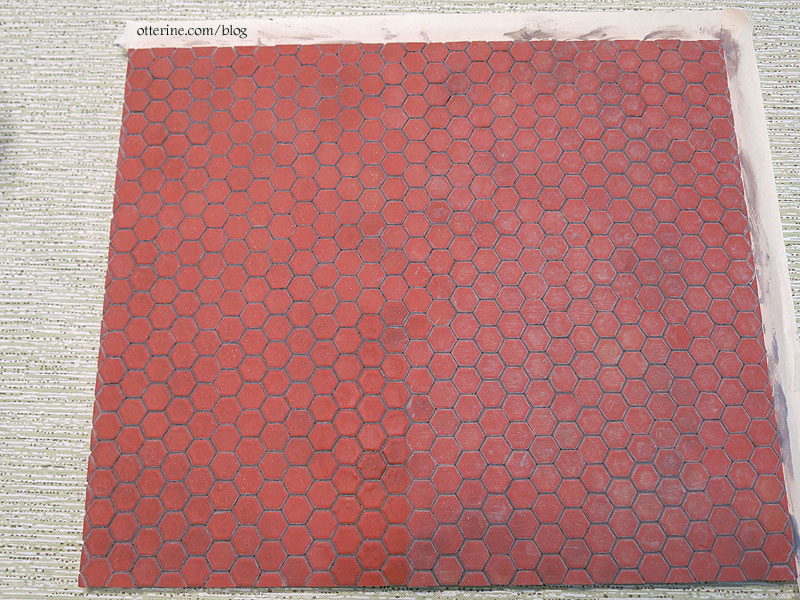
Once done, I wiped the entire floor with a damp paper towel again.

Then I wiped it dry. Very little color lifted in the last pass, so I called it done.

The final result has less color variation than the plain tiles, but I like that better.
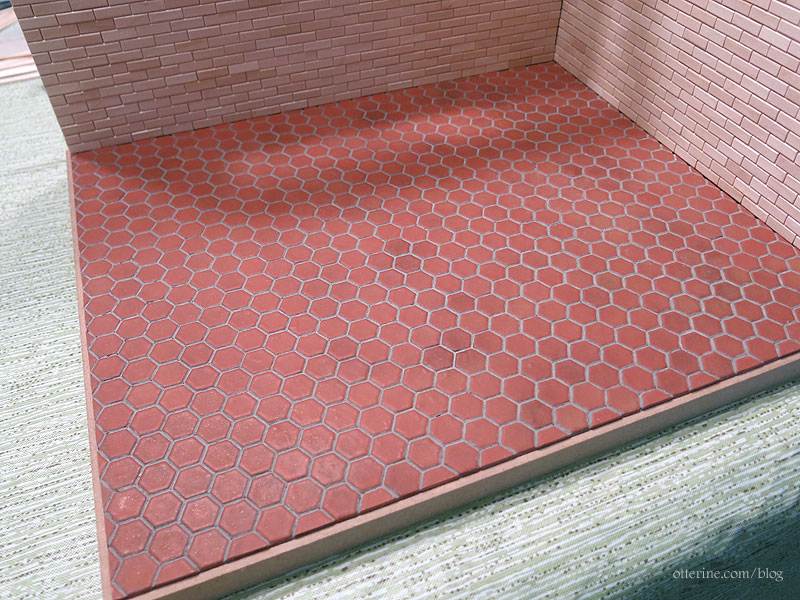
I’m glad I gave it a try. :]
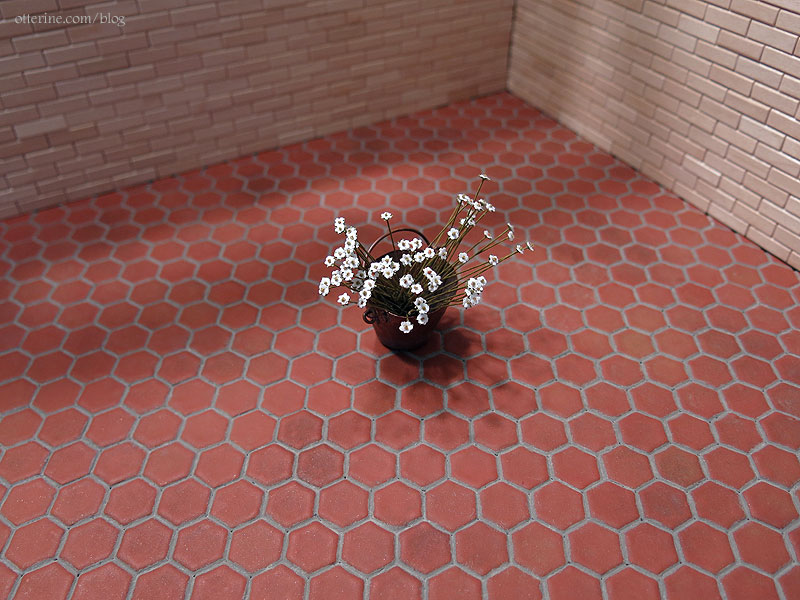
Categories: Polymer clay, Whinnie's Terrace
November 4, 2020 | 0 commentsHexagon clay tiles, part 2
Continuing work on the hexagon clay tiles. The bottoms of the clay pieces turn out shiny from the ceramic tile base, so I sanded them lightly before gluing. I also lightly sanded the mdf floor board.

I used Weldbond to glue to the tiles to the floor board. I made roughly 30 groupings, and some fell apart in the process. Those I used to piece between and around the larger groupings.
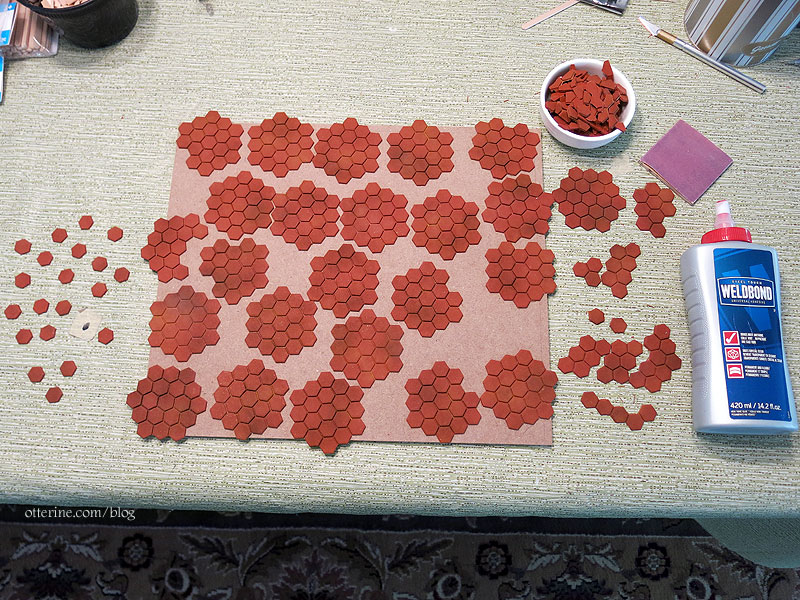
Since the individual hexagons had different measurements across depending on their orientation, I needed to make sure all of my hexagons were going the same direction. I measured each grouping and individual tile before gluing in place. I wasn’t guaranteed to have perfectly uniform application, but this gave me a fighting chance. :D
I started by laying out the edge sections and by luck ended up with full tiles front to back and side to side.

Since the tile groupings were unstable, I used a putty knife to pick them up and handle them.
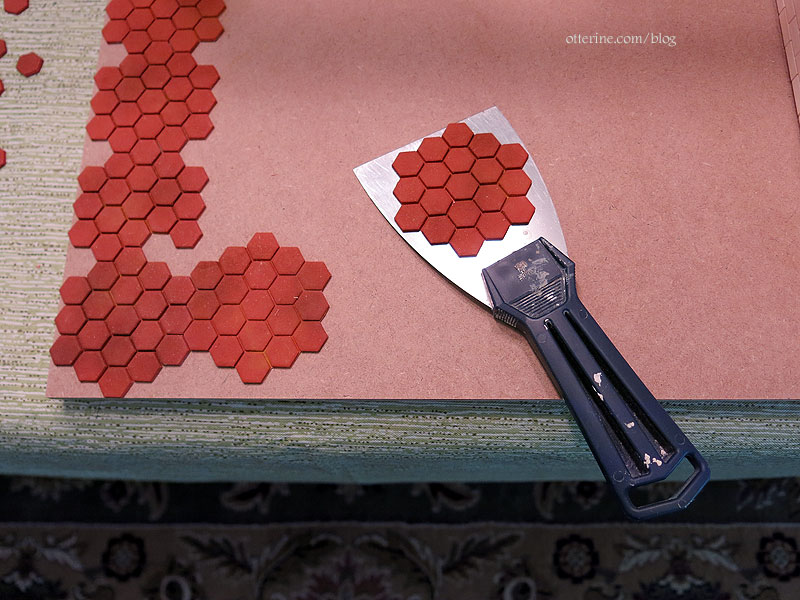
I tried to keep the groupings intact as much as possible, leaving small sections to piece later.
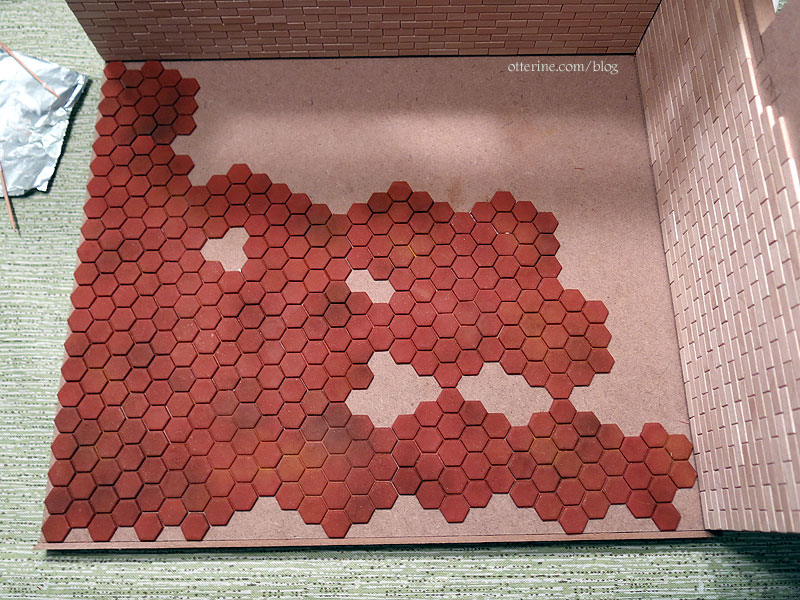
My bowl of scraps helped fill in the edges. Tedious, but I kept at it!
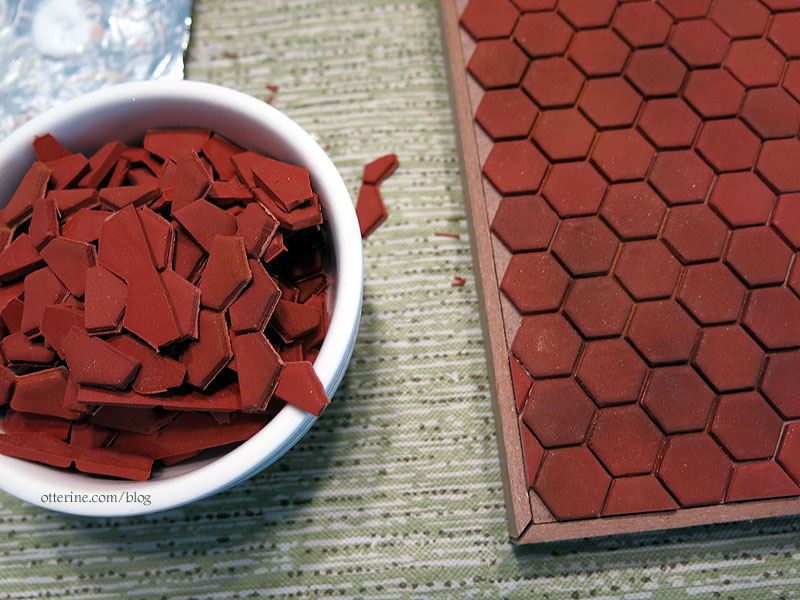
Hooray! :D
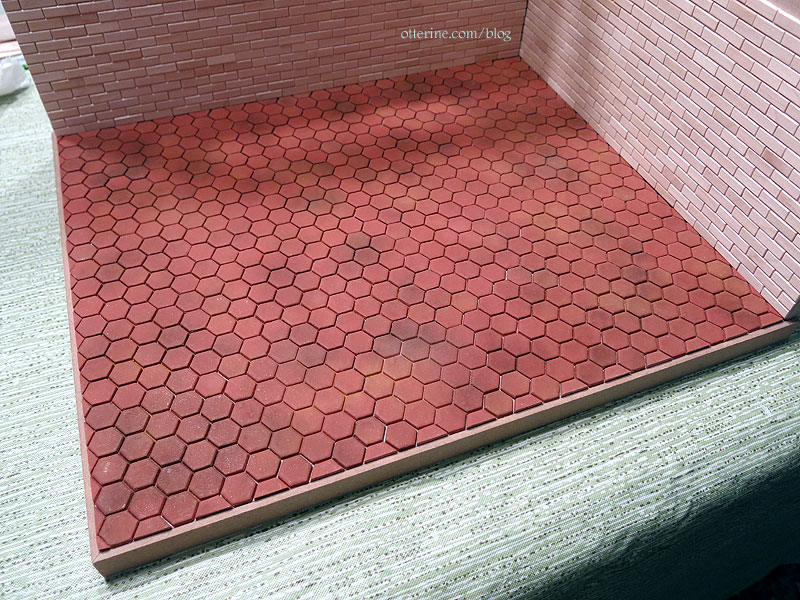
There’s finishing trim for the base on the front and side, but I didn’t apply tile all the way to those edges. I will add strip wood around the tile to protect and finish the edges. The spacing didn’t end up completely uniform but it’s close enough that it shouldn’t be obvious after grouting.
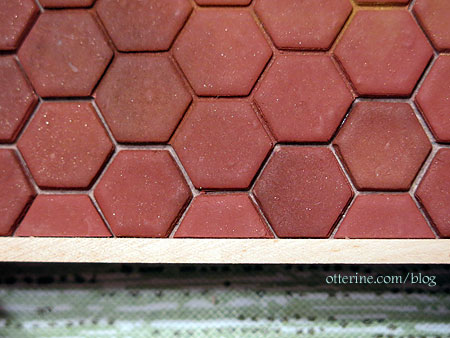
Categories: Polymer clay, Whinnie's Terrace
November 3, 2020 | 0 commentsHexagon clay tiles, part 1
For my project, I envisioned hexagon terracotta tiles. You can buy these already made, but that can add up quickly. I also wanted to see if I could do it myself since I’ve worked with clay before. I bought Original Sculpey in terracotta. I have a ceramic tile working base, roller and cutter I found on eBay. More on the cutter in a moment.
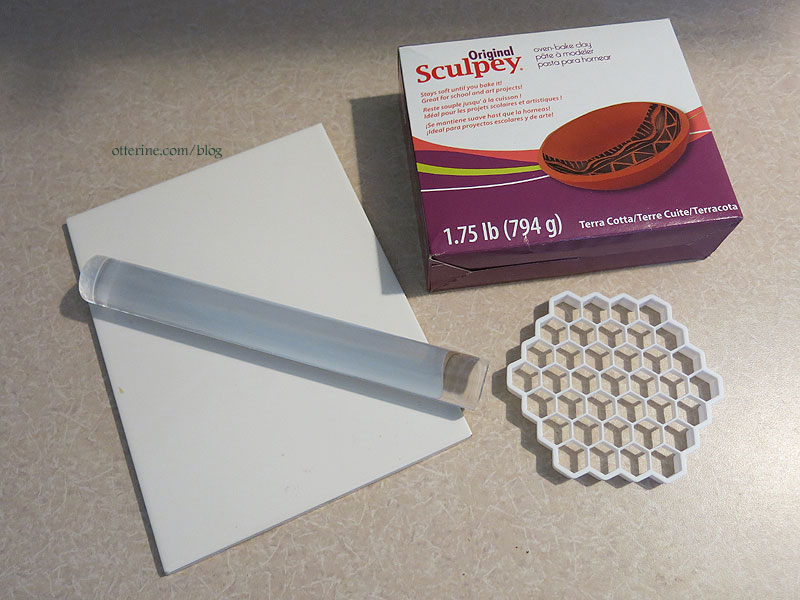
I taped 1/16″ thick basswood strips to the ceramic tile and rolled out the clay. It’s soft and easy to work with. I had to cut away the edges a few times as the clay spread out.
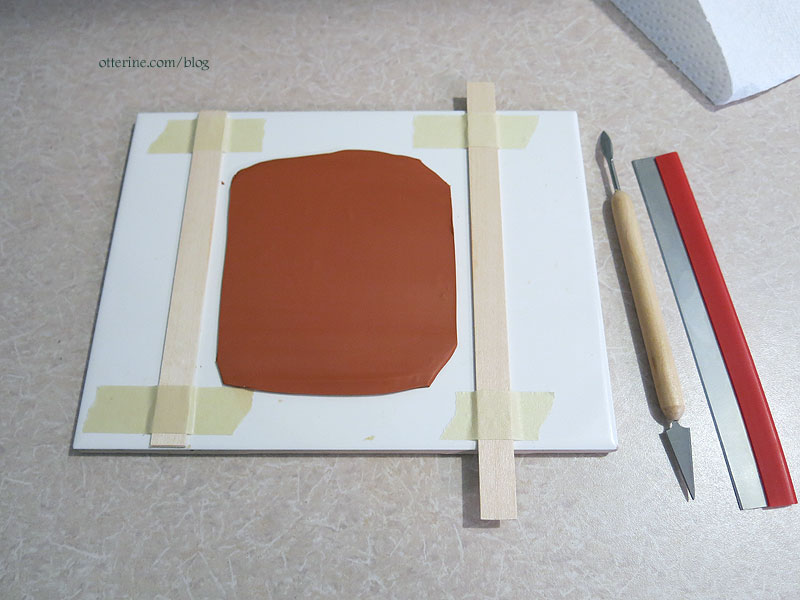
I’m using bronzer (make-up powder) to dust the cutter since I didn’t want white powder contrasting with the color of the tiles. It has some shimmer to it, which is a nice surprise. Very upscale tile made with gold dust. I did get too much bronzer on the first batch, but I was able to tone it down on the subsequent batches. The first batch will be my test sample for grouting and finishing.
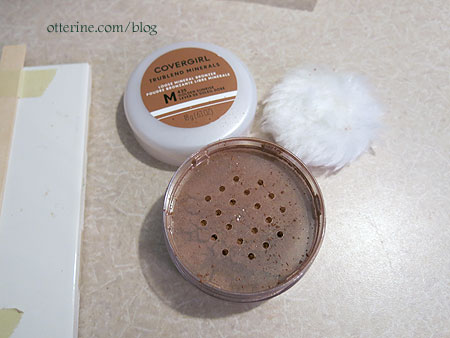
The cutter is designed to cut cookies/biscuits and leave a honeycomb design in the middle, so it has a deeper outer edge than the center pattern.
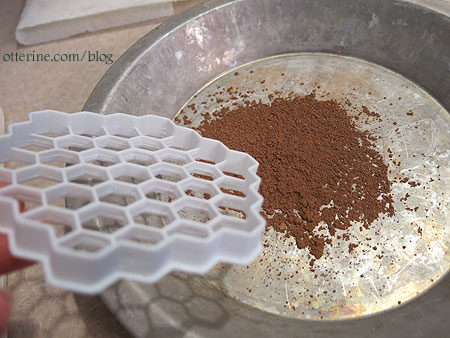
But, the other side is very uniform, so I just used it upside down.
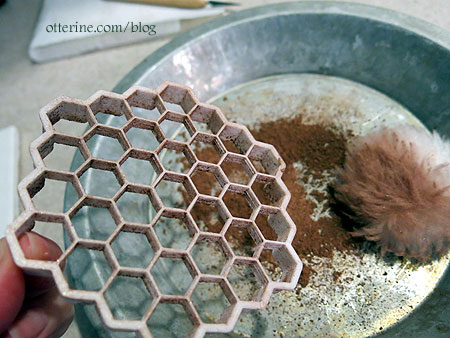
I pressed the cutter into the clay with a board.
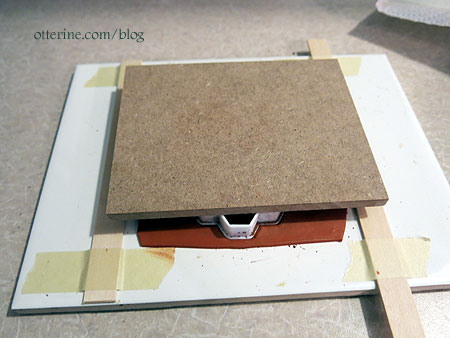
I patted the clay with a dry brush to remove some sheen and provide slight texture.
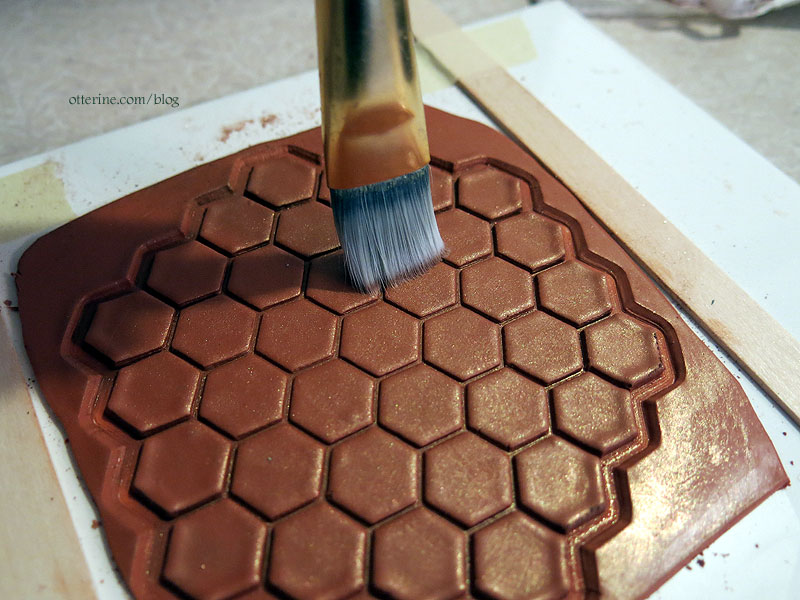
I shaved some pastels into a palette and dry brushed the tiles to vary the coloration. The chalk texture tones down the sheen, too. I used more on the later batches, and it looked better.
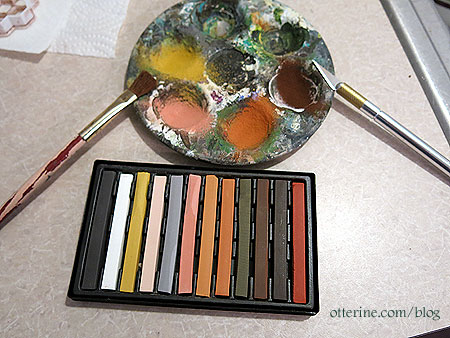
The cutter did not go all the way through, which was fine. The tiles around the edges aren’t usable because of the way the cutter is being used, but the middle ones turned out quite nice. I did cut away a lot of the scrap to reuse, but I baked the remaining shape intact otherwise. I’d rather cut the tiles apart after they bake instead of risking ruining them by cutting them before.
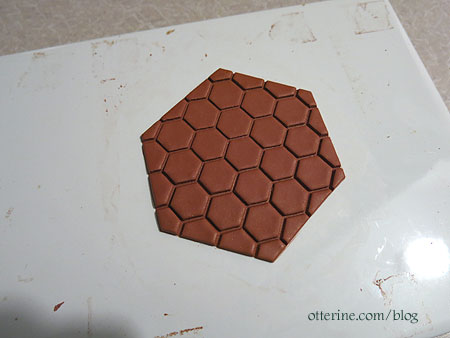
Choosing the baking time is always difficult for small, thin pieces of polymer clay, because you don’t want to burn the clay or end up with brittle pieces. I saw a video where 2mm strips (roughly 1/16 inch – the thickness I am making) were baked for 10 minutes and 60 minutes. The instructions on the clay package indicate baking 15 minutes per 1/4 inch. The video’s 10-minute sample snapped when bent and the 60-minute one was bendy and durable. I am going with 35 minutes to speed things along. After the first batch, I tested the clay after it cooled. It did eventually split when bent, but it took some force. For tiles that will be glued to a board, I called that a success.
I cut away the outer bits and left the main shape intact. I wanted to get a few batches done to see if I could lay them out in these large sections and then piece between them instead of laying tiles out one at a time.
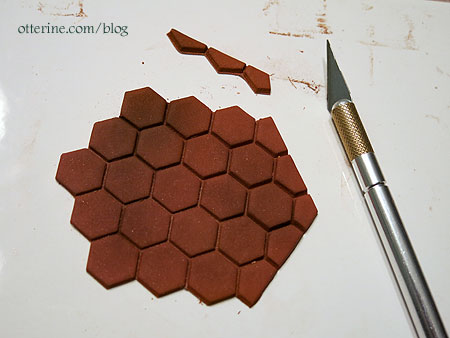
I saved the leftovers since I will have to piece around the edges.
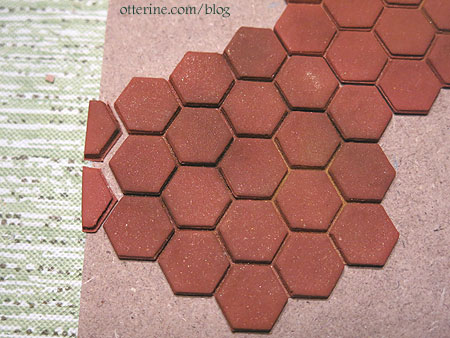
I have a lot to make! :O
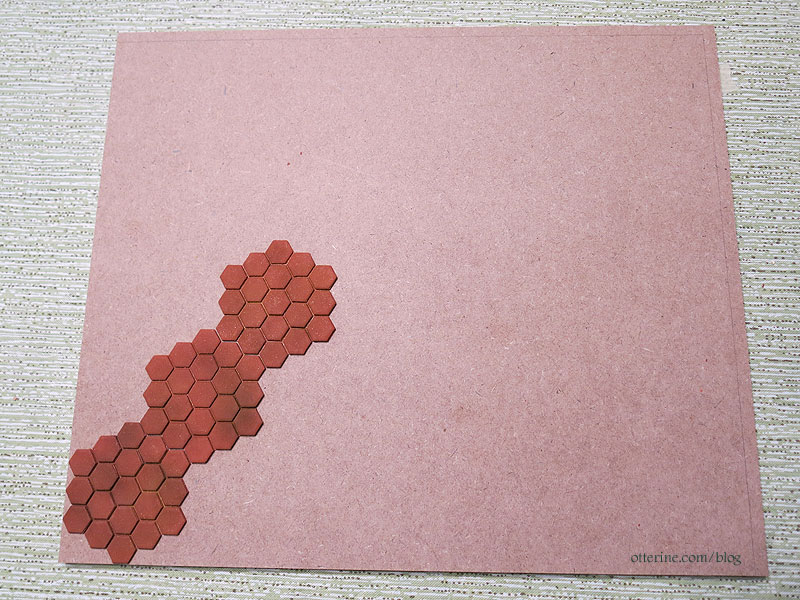
So, I started doing two at a time.
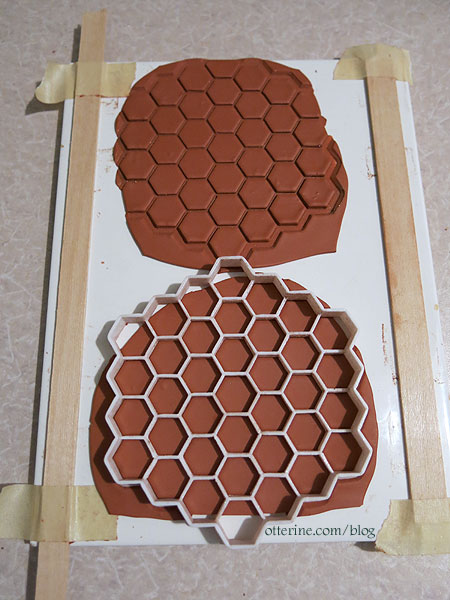
Categories: Polymer clay, Whinnie's Terrace
October 30, 2020 | 0 commentsMushrooms!!!!
I am finishing up some landscaping for the final Heritage post showcasing the exterior and the overall build itself. But, I thought this element deserved its own post…mushrooms!!! :D

I started with Peiwen Petitgrand‘s book on making clay food.
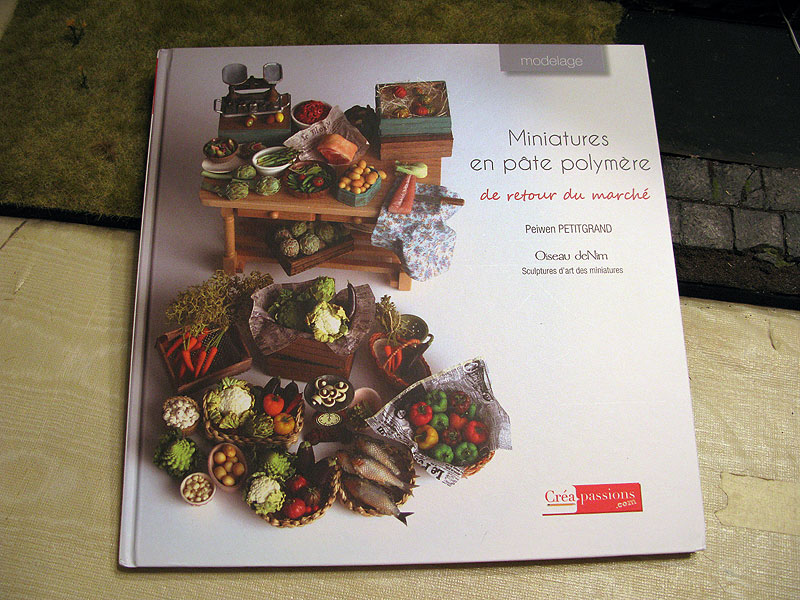
I had already planned to start with mushrooms since I wanted some for the Heritage lawn. Her instructions are wonderful, even though my French is very rusty. I was able to figure out the basics well enough. I made only a few changes. I added pastel coloration before baking and made the stems longer to have something to plant in the ground. I also made my molds a little variable, misshapen and left any imperfections. It translated into a more realistic result. :D

The undersides have the slotted detailing like the real thing. Even though it’s nearly impossible to see once the mushrooms are planted, I love knowing it’s there.

I planted them all around The Tree but wonder if these will last the night with Grahame on the loose! :O
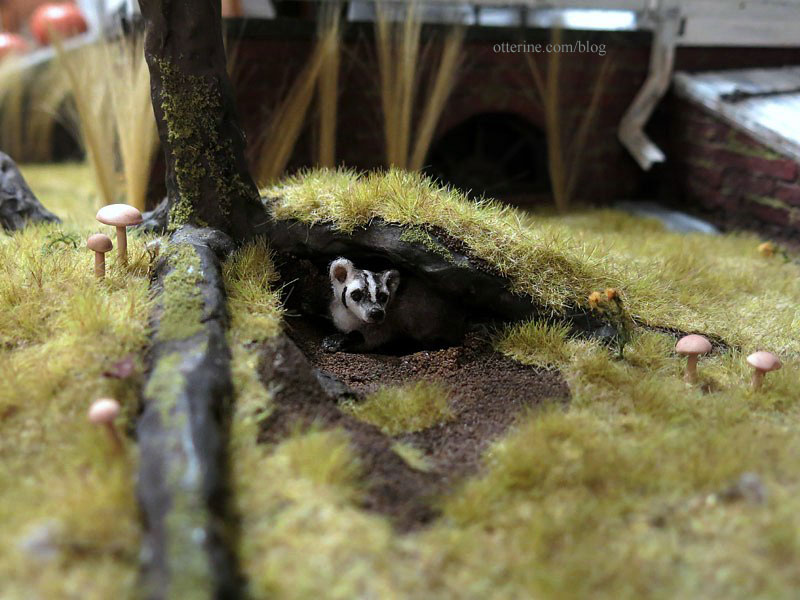
I might be making more tomorrow. Haaaaa!

Categories: Polymer clay, The Haunted Heritage
August 18, 2013 | 0 commentsBaking in mini – my maiden voyage
I used to make clay foods when I was young for my childhood dollhouse, but that was limited to mostly hamburgers. :D Since rediscovering minis as an adult, I’ve seen so many talented food artisans online and at the mini shows.
I recently bought some suitable colors of clay and started experimenting.
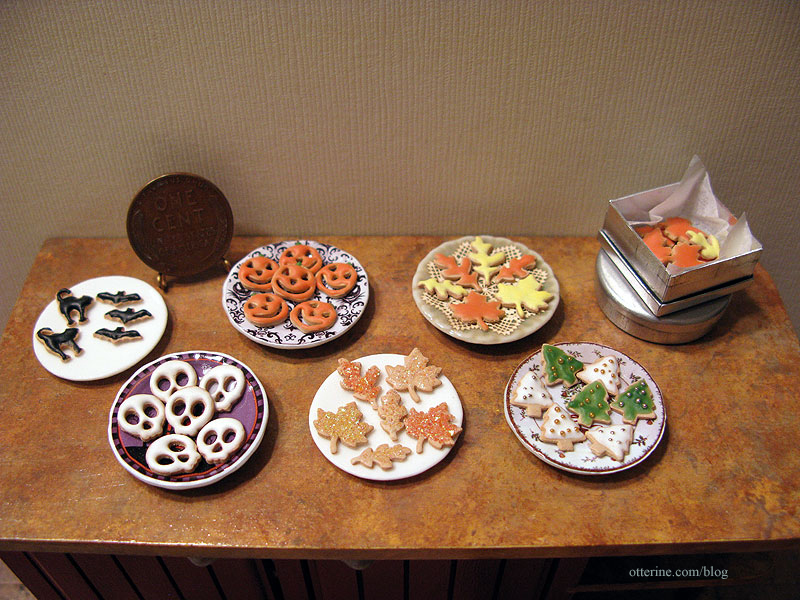
Here is the first batch of cookies using Fimo clay in the color sahara. I started with bats and cats since making festive cookies was part of the to-do list for my Halloween display that I didn’t have time to finish before the holiday.
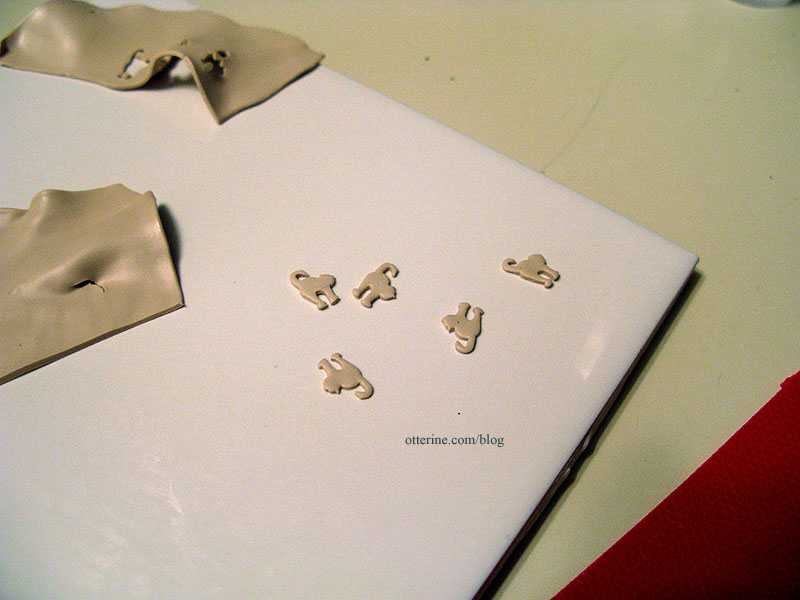
I used chalk pastels to give them some golden color. After baking, they really do look like plump, warm-from-the-oven cookies! :D
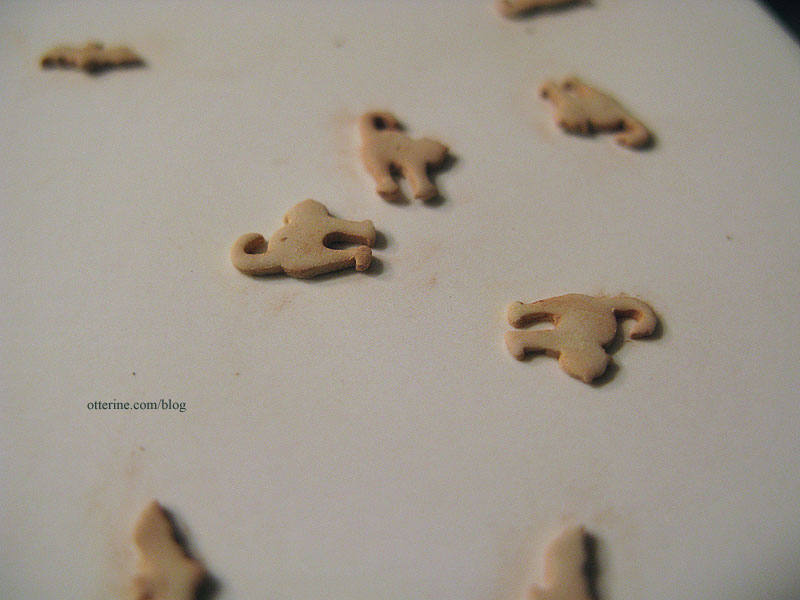
I used clay mixed with the Translucent Liquid Sculpey as well as oil paint mixed with the Translucent Liquid Sculpey to make icing for the cookies. The oil paint was certainly easier to mix and work with, so I will pick up a starter set of colors next time I head to the store.
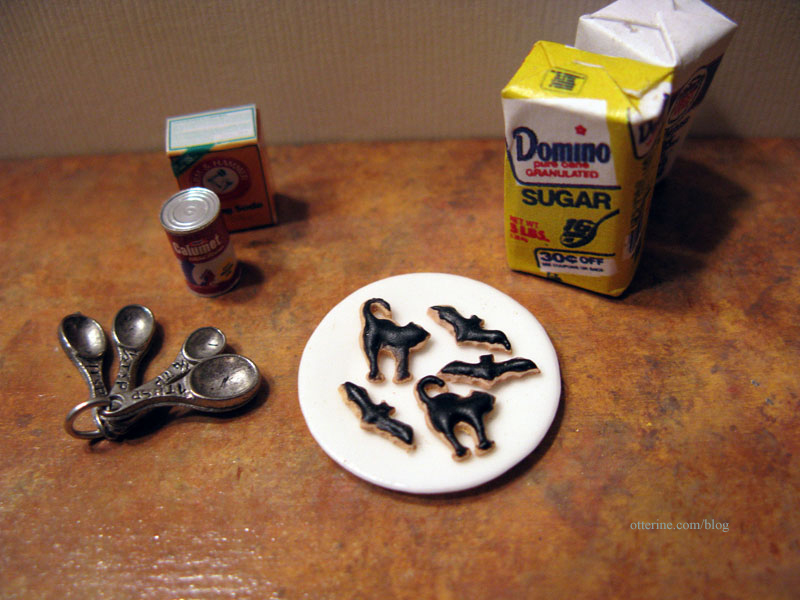
Here’s a plate of skulls with white frosting. I don’t know why, but these are my favorite. :D
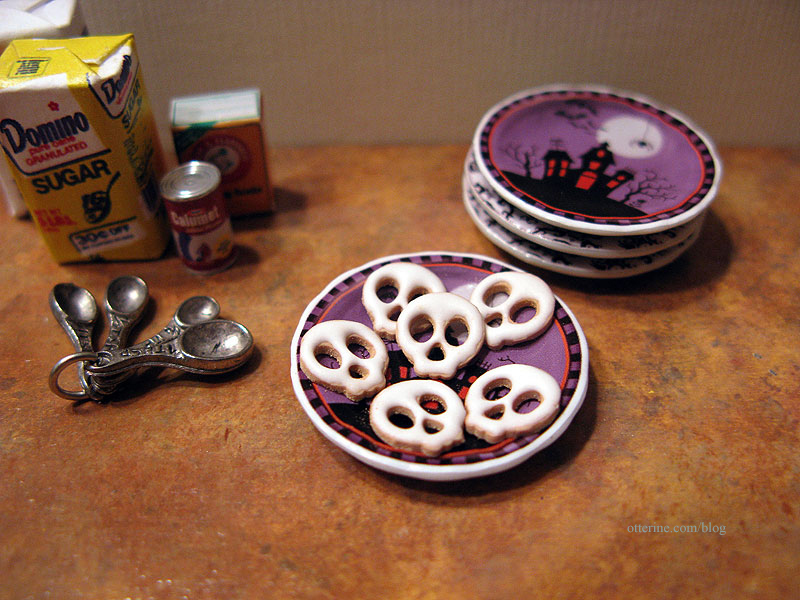
The pumpkin cookies are rather fun, too.
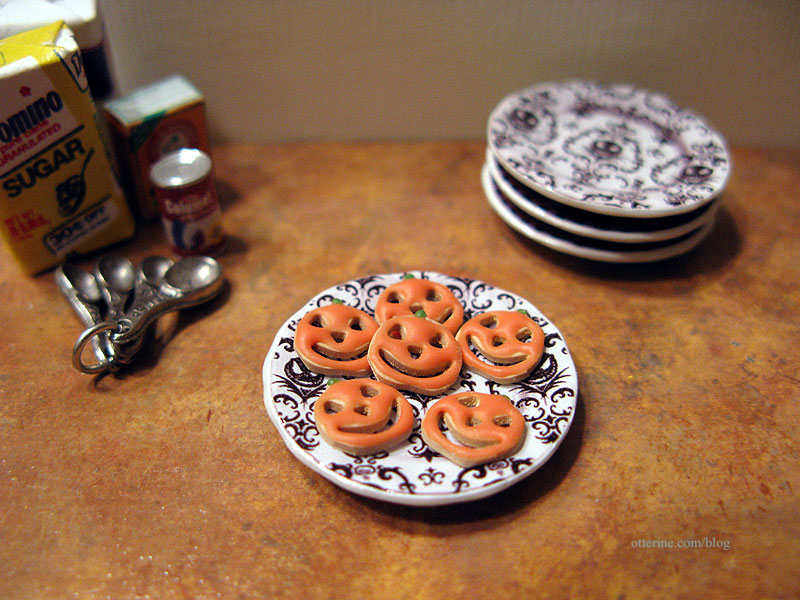
The leaf cookies could be used for the general autumn season or for a Thanksgiving setting.
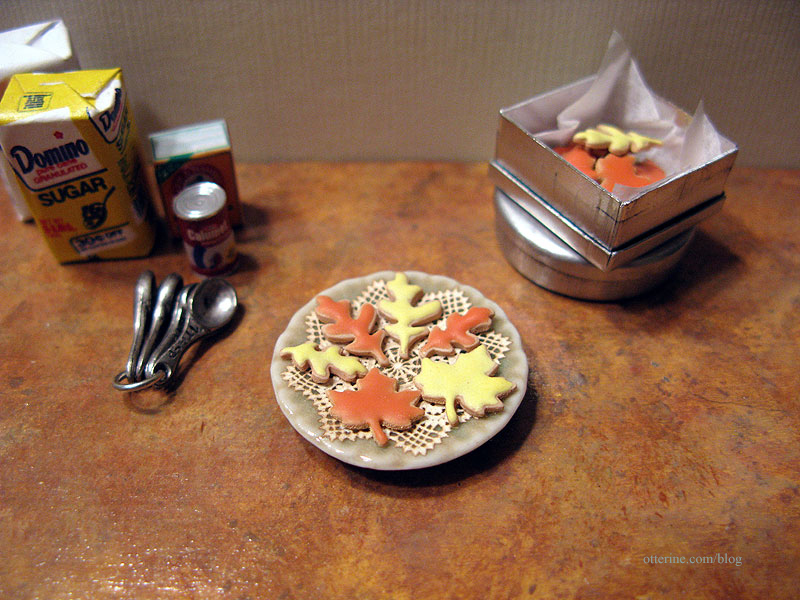
I left some of the leaves bare and decided to try a different method, coating them in three shades of glitter to mimic sugar cookies.
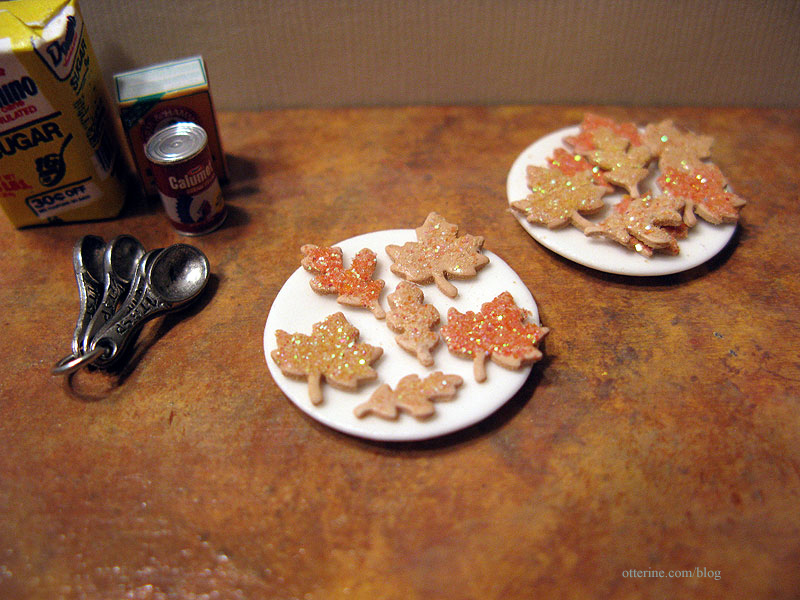
The frosted Christmas trees have added micro beads in gold and silver.
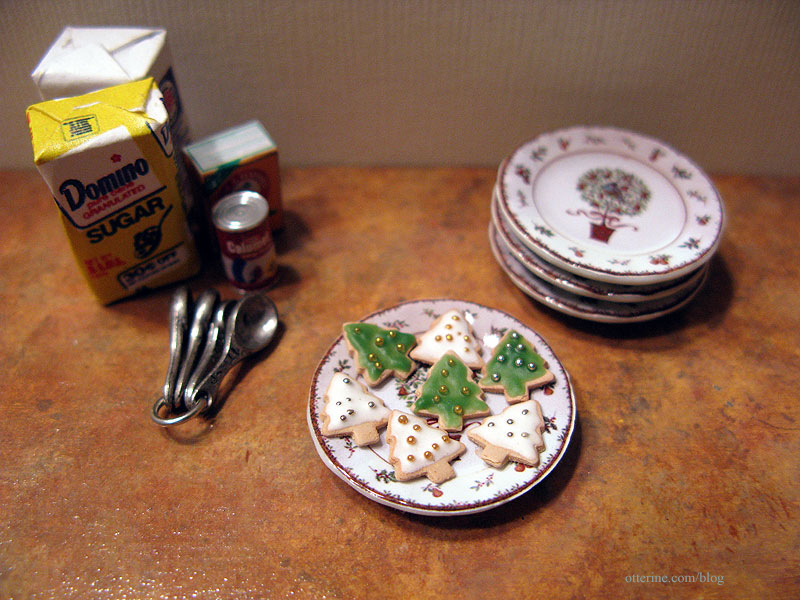
I spent all day on these lovelies and certainly had fun, but after all that work…there aren’t any cookies I can actually eat!!!! :O
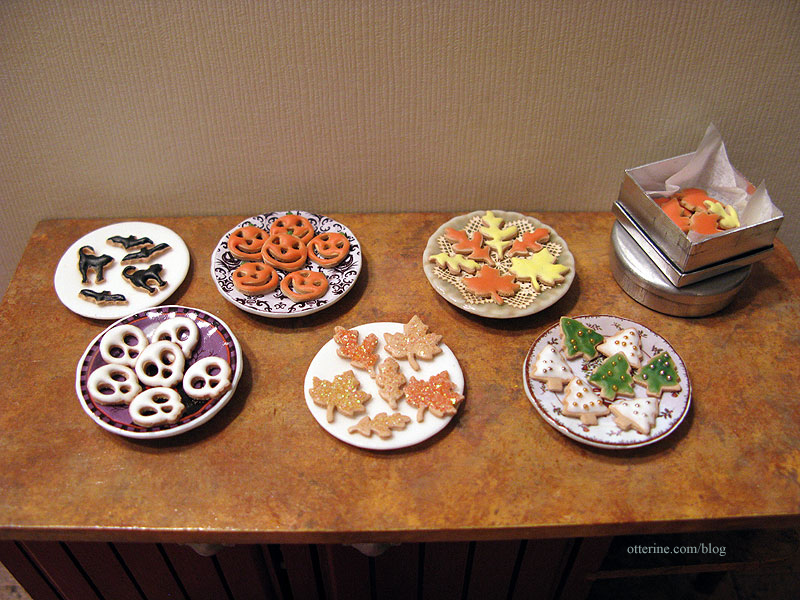
Two designs of Halloween plates and Christmas plates from A Lavender Dilly. Plate with doily from Stewart Dollhouse Creations.
Categories: Miniatures, Polymer clay
November 3, 2012 | 0 commentsJack-o’-lantern
What’s a Halloween display without a jack-o’-lantern?! Ophelia wouldn’t hear of it!
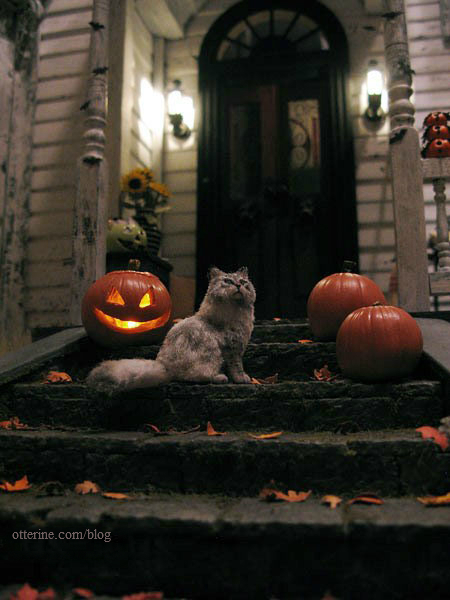
I’ve seen many techniques used online and in books for making hollow pumpkins from polymer clay. Most often something is baked inside: styrofoam, foil or a glass marble. Each of these has pros and cons. The styrofoam just seems noxious to bake, but maybe I’m wrong. The glass marble can cause breakage when you try to remove it, which makes me worry about all the effort to make it look good being ruined in an instant. The foil doesn’t seem the easiest to remove, but it seems the least noxious and easier than the marble…so that’s the way I went.
I used Fimo ochre clay around the foil ball and then added Fimo cognac clay around the clay ball. This way, the inside would be lighter than the outside once carved.
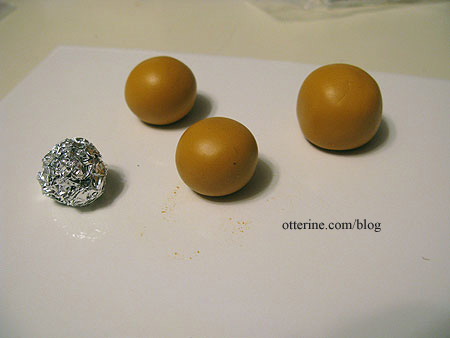
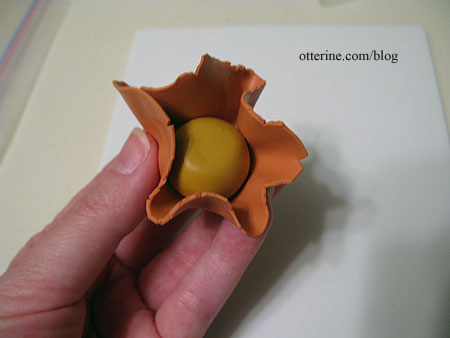
I added lines and texture but decided to carve my pumpkin after baking to minimize handling while the clay was pliable. I did plan to leave one or two of the pumpkins intact just for decoration, but I made all three the same way just in case.
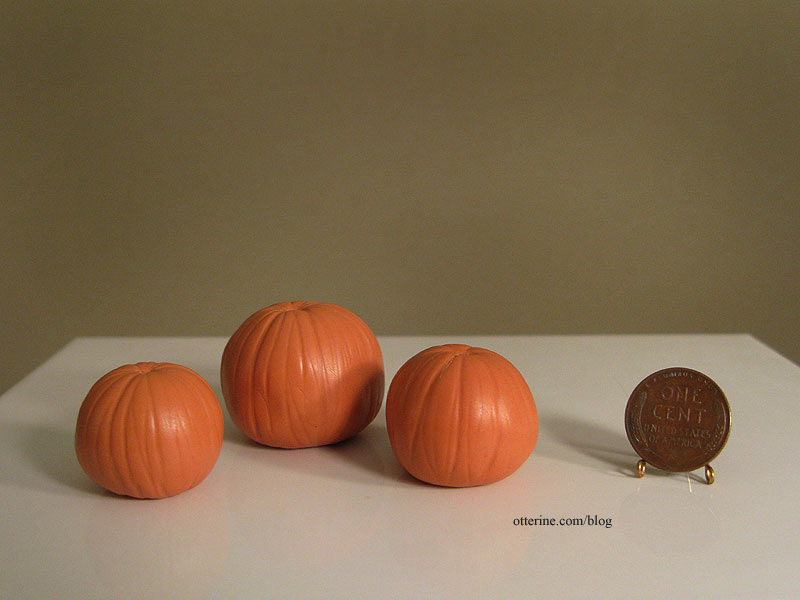
I used pastels to color the clay before baking to deepen the color and emphasize the sculpted lines. Here they are after baking.
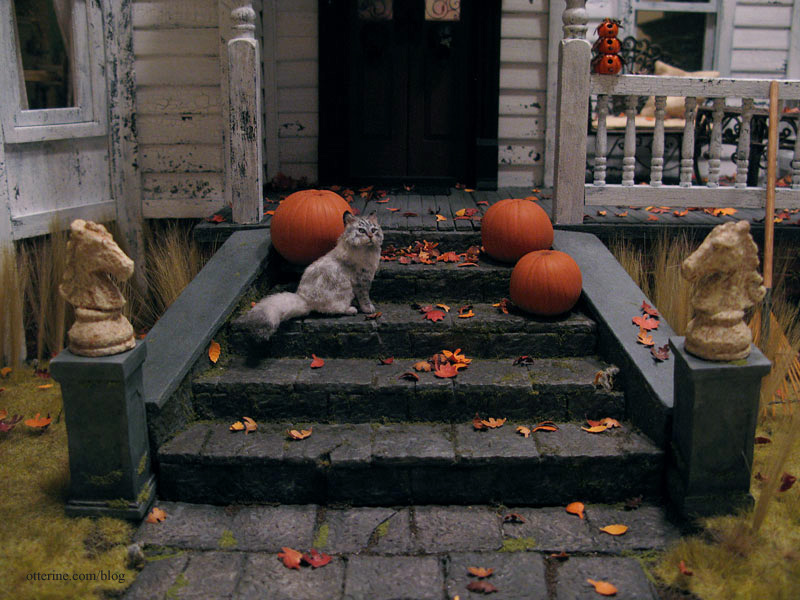
After the clay cooled, I cut the removable top, removed the foil innards and carved the pumpkin face. None of these things proved easily done. The clay was thicker and harder than I thought it would be. It didn’t ruin the illusion in the end, but I ended up making only this one for lack of time.
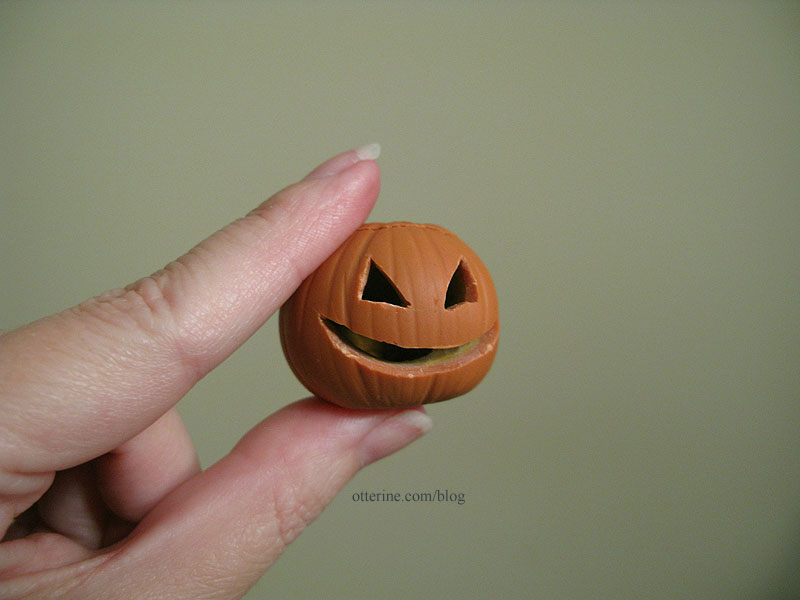
I used a grape stem for the top, an idea I saw on Joann Swanson’s blog. I used the larger main stem, though, and it was still green. I microwaved it to dry it out, and bleh…did it ever smell bad. Hahahaha
After gluing the stems on, I brushed on a thin coat of Sculpey satin glaze, even on the stems to seal them. It gives them a wonderfully realistic waxy finish. It also disguises the cutting and carving marks.
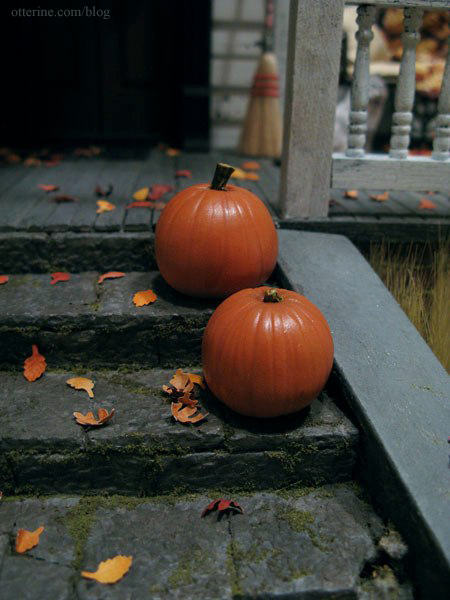
I drilled a hole in the bottom for the LED.
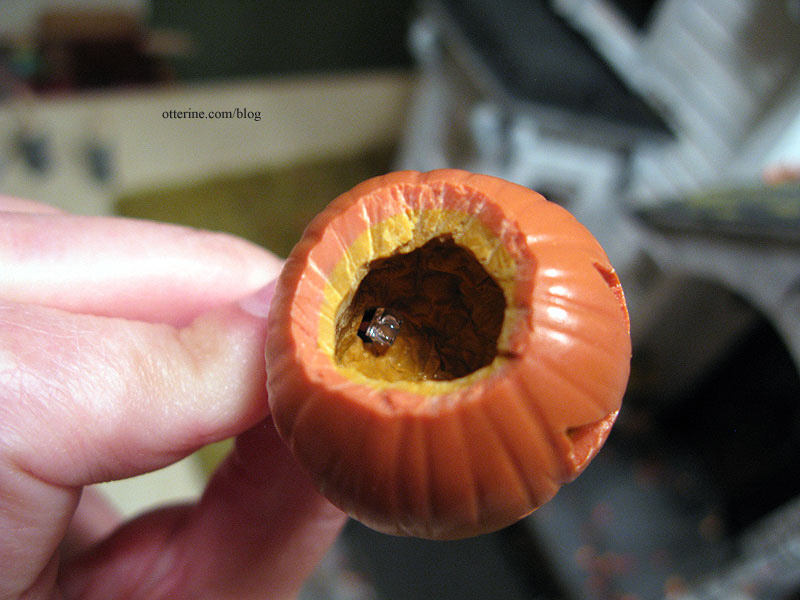
These are flickering LEDs from Evan Designs. They attach to a 3V battery adapter with a switch and come in yellow or orange. I bought both colors since I wasn’t sure which would look better, or if I would want a combination of the two. I ended up using a single orange bulb for my jack-o’-lantern since it was the better color of the two and plenty bright on its own.
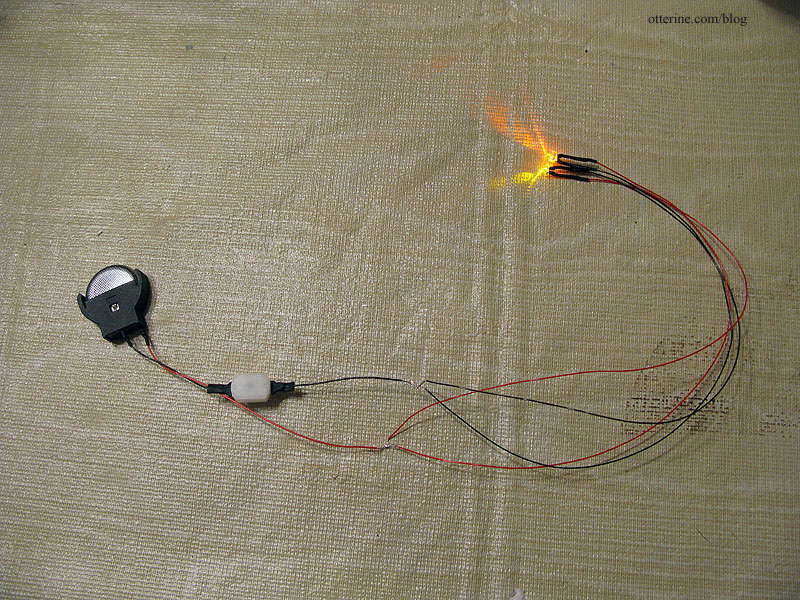
I had already run the wire through the foundation so I could operate the switch in the cellar doors. Here’s the battery and switch in the cellar.
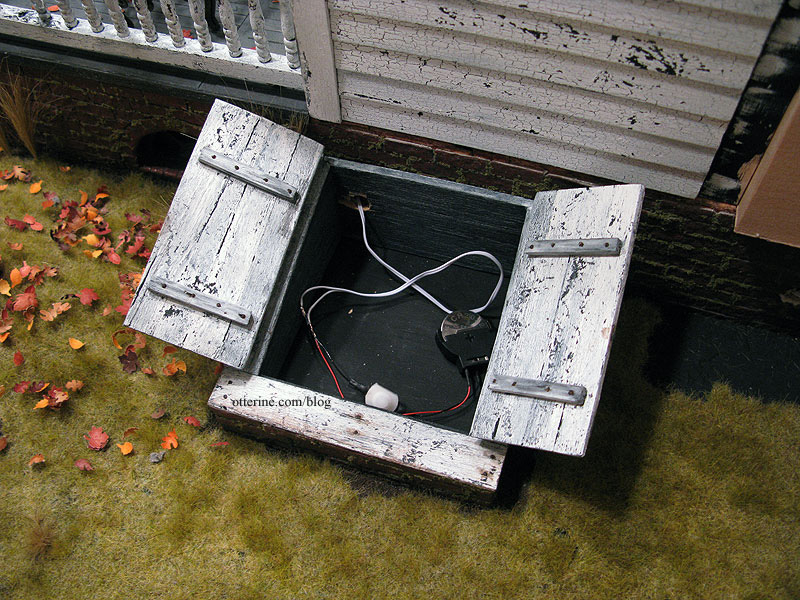
The light is on and pumpkins are in place! Hooray!
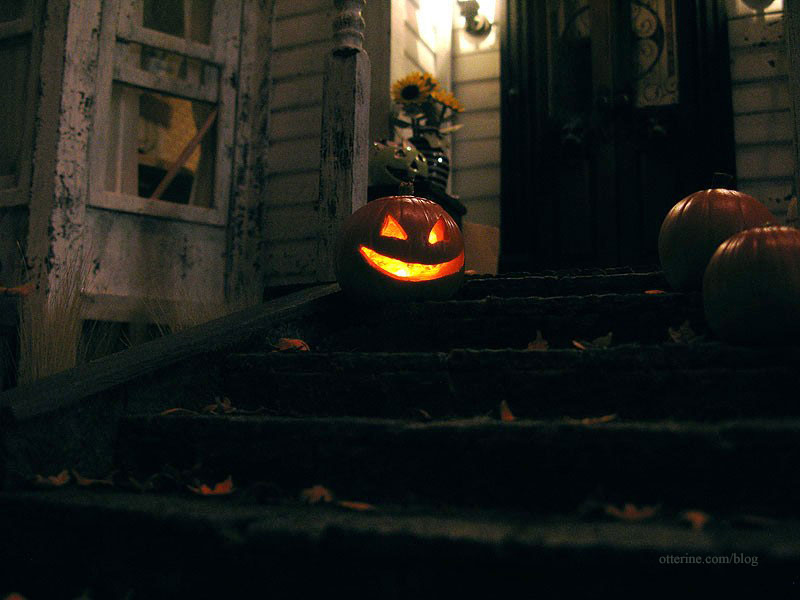
I think this requires a movie. ;D I apologize for the poor quality of the video, but it’s the best my camera will do. At least you get to see the flickering LED!
I will definitely use these flickering lights for the parlor fireplace, too. That wiring will be an easier endeavor to accomplish, though.
Categories: Polymer clay, The Haunted Heritage
November 2, 2012 | 0 commentsWhooooo’s a cutie?!
One of my favorite animals is the owl, and I especially love the Burrowing Owl. I have a printout of an image of a Burrowing Owl chick on my wall at work. It makes me smile. :D
I’ve been so inspired by the work of Anya Stone and Kerri Pajutee, two amazing artisans who make the most realistic miniature animals I’ve ever seen. I’ve wanted to make a Burrowing Owl for some time now, so I decided to just hop to it! Kerri has two great tutorials on CDHM: one for sculpting a bird and another on flocking and feathering. I used those as a basis to start my mini owl.
I decided to make an adult Burrowing Owl.

image by Nature’s Pic’s Online I was lucky to find a good photo of the back of the owl, too (see photos by Ecobirder).
I sculpted my bird using white polymer clay, though it got fairly dirty as I worked with black wire to make the legs and feet. The feet look a bit big, but it was the only wire I had and the flocking and feathering will add weight once applied. To get the bird to stand while baking, I tied some wire around the ceramic tile I use for baking clay.

After baking and cooling, I painted the whole piece with light tan acrylic paint. I also painted the eyes and beak before feathering. Caution: naked birdie below…

I bought two types of feathers, using the darker ones for the tail feathers and back and using the lighter ones for the breast. I used embroidery floss to make the flocking. I cut all but the spotted and striped portions from the feathers. I followed Kerri Pajutee’s tutorial for placement for the most part but tried to use the natural patterns of my feathers to mimic those of the Burrowing Owl.

Here are some photos of my owl as the feathering progressed…



And, finished! :D

I love him!!!!! I don’t think I did half bad my first time around if I do say so myself.
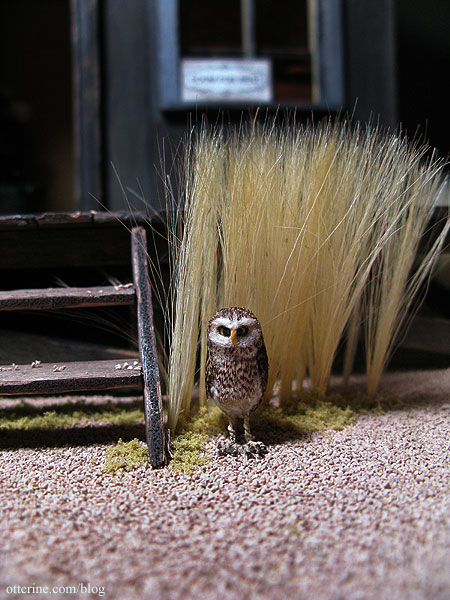
And, he looks right at home on Baslow Ranch! :D
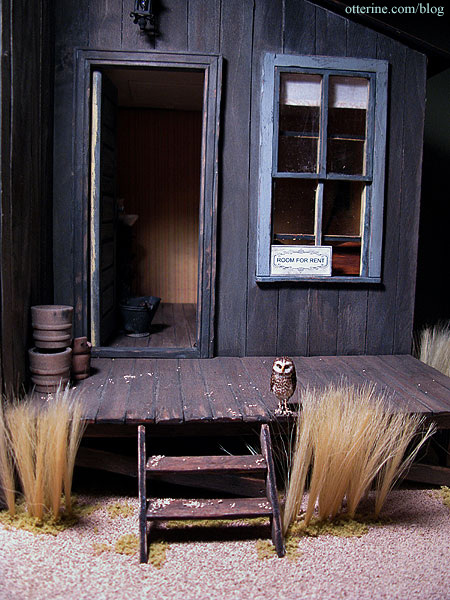
Categories: Animals and birds, Polymer clay
August 20, 2010 | 0 comments
NOTE: All content on otterine.com is copyrighted and may not be reproduced in part or in whole. It takes a lot of time and effort to write and photograph for my blog. Please ask permission before reproducing any of my content. (More on copyright)

Cat mummies
Many moons ago, I bought a cat mummy kit from L Delaney. One thing I didn’t realize about the kit was that it contained air dry clay. It was hard as a rock, so I used Sculpey terracotta color polymer clay since I have a lot of it and you paint the mummies anyway. It’s also soft and easy to work with.

The paint included was also dry but I was able to reconstitute it with water. I made a swatch of it, so I could mix more of a similar color in the future. The kit comes with a lot of paper to use as mummy wrap, and you use 1/16″ wide strips. I could make a lot of mummies, but I started with a pair hoping to get at least one good one.

I ended up with two that complement one another well, don’t you think? :D

Ra and ibis statues by Neil Carter; ceramics by Carberlin Minis.
Categories: Animals and birds, Miniatures, Polymer clay
July 2, 2022 | 0 commentsHalloween cake with wee ghosts
I made a cake following the tutorial by Maive Ferrando in Dolls House and Miniature Scene magazine. I had to change the method a bit for my own skill level and techniques I’m more comfortable with, and I’m happy with the end result. I made my cake whole and added a tombstone cookie.

Categories: Miniatures, Polymer clay
October 24, 2021 | 0 commentsZombie apple cookies
In continuing with my polymer clay adventures, I thought I would make some poison apple cookies to go with my poison apple cake. Well, the best laid plans….
After forming the apple cookies, painting on the green icing and then adding the black icing, all was going well. Until the black icing shifted more than expected during baking.
This is what I was going for, and this is the only one that turned out like my vision.

The remaining are these. I thought they were outright fails, until I showed them to my miniaturist group and they raved about them. :D Sometimes I think people are just being nice, but in this case, they bought them all up save four! It made me feel better about my perceived failure and turned these into a happy accident. Thus, the zombie apple cookie was born.

I did end up putting some sets on etsy if anyone else is taken with these zombified cookies.


Categories: Miniatures, Polymer clay
October 17, 2021 | 0 commentsPoison Apple Cake
I’ve seen a few examples of poison apple cakes in real life and wanted one in mini. After a few failed attempts, I have a keeper!

I made two more for a couple of friends. :D These are challenging but so much fun!

——
You can see the real life inspirations here and here.Dandelion by Lamis Minis, poison bottle from Four Little Walls, doily from Stewart Dollhouse Creations, mouse purchased years ago (unknown vendor).
Categories: Miniatures, Polymer clay
September 3, 2021 | 0 commentsBread dough bowls
This past month, I made up some rising bread dough bowls using polymer clay. Today, I spent time making the kitchen towels used to cover them. In reality, the towel would cover them completely, but in mini, I let some of the dough peek out. Perhaps the baker is checking for readiness. One is for me, but the others will be in my etsy shop.






Categories: Miniatures, Polymer clay
August 28, 2021 | 0 comments
NOTE: All content on otterine.com is copyrighted and may not be reproduced in part or in whole. It takes a lot of time and effort to write and photograph for my blog. Please ask permission before reproducing any of my content. (More on copyright)



